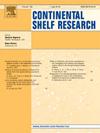在巴西南部的圣卡塔琳娜岛,一项为期三年的对已孵化的依拉斯莫科卵囊的调查
IF 2.2
3区 地球科学
Q2 OCEANOGRAPHY
引用次数: 0
摘要
在一项为期三年的调查中,本研究调查了巴西南部圣卡塔琳娜岛六个海滩上孵化的依丝木纲卵囊的多样性。记录了7个鲨科分类的卵囊(1773个),其中包括6个鳐分类(Atlantoraja castelnaui, Atlantoraja spp, Psammobatis spp, Rioraja agassizii, Sympterygia acuta和Sympterygia bonapartii),值得注意的是,在巴西海滩上首次报道了鲨鱼卵囊,斑点猫鲨Scyliorhinus haeckelii。选取采集卵囊数最多的3种(90粒),评价温度对其繁殖周期的影响。有优势的胶囊在温暖的季节(春季和夏季)acuta和Psammobatis spp。没有显著差异的数量卵囊在冷与热之间(秋季和冬季)季节r . agassizii暗示一个活跃的生殖模式。我们还利用阿加assizii的数据验证了6个海滩之间卵囊数量的差异,这些数据与岛上受风和盛行洋流保护的地区(岩石海岸线,岛屿)有关。这些发现对于增加对南大西洋西部板鳃纲卵生物种的认识具有重要意义,强调了卵囊监测对了解当地物种的生物多样性和生殖生态的重要性,这对制定有效的保护策略至关重要。本文章由计算机程序翻译,如有差异,请以英文原文为准。
A three-year survey of hatched elasmobranch egg capsules on Santa Catarina Island, Southern Brazil
Over a three-year survey, the present study investigated the diversity of hatched elasmobranch egg capsules along the six beaches of Santa Catarina Island, Southern Brazil. Egg capsules (1,773) from seven elasmobranch taxa were record, including six skate taxa (Atlantoraja castelnaui, Atlantoraja spp., Psammobatis spp., Rioraja agassizii, Sympterygia acuta, and Sympterygia bonapartii) and, notably, the first report of a shark egg capsules on a Brazilian beach, the frecked catshark Scyliorhinus haeckelii. The three species with the highest number of collected egg capsules (>90) were selected to assess the influence of temperature on their reproductive cycles. There was a predominance of capsules in the warm (spring and summer) season for S. acuta and Psammobatis spp. There was no significant difference in the number of egg capsules between warm and cold (autumn and winter) seasons for R. agassizii, suggesting an active reproductive pattern throughout the year. We also verified the difference in the number of egg capsules among six beaches using data from R. agassizii which was related to areas sheltered (rocky coastline, island) from winds and prevailing ocean currents along the island. These findings were important to increase the knowledge of oviparous elasmobranch species from the Western South Atlantic, underscoring the importance of egg capsule monitoring to understand the biodiversity and reproductive ecology of the local species, which are crucial for effective conservation strategies.
求助全文
通过发布文献求助,成功后即可免费获取论文全文。
去求助
来源期刊

Continental Shelf Research
地学-海洋学
CiteScore
4.30
自引率
4.30%
发文量
136
审稿时长
6.1 months
期刊介绍:
Continental Shelf Research publishes articles dealing with the biological, chemical, geological and physical oceanography of the shallow marine environment, from coastal and estuarine waters out to the shelf break. The continental shelf is a critical environment within the land-ocean continuum, and many processes, functions and problems in the continental shelf are driven by terrestrial inputs transported through the rivers and estuaries to the coastal and continental shelf areas. Manuscripts that deal with these topics must make a clear link to the continental shelf. Examples of research areas include:
Physical sedimentology and geomorphology
Geochemistry of the coastal ocean (inorganic and organic)
Marine environment and anthropogenic effects
Interaction of physical dynamics with natural and manmade shoreline features
Benthic, phytoplankton and zooplankton ecology
Coastal water and sediment quality, and ecosystem health
Benthic-pelagic coupling (physical and biogeochemical)
Interactions between physical dynamics (waves, currents, mixing, etc.) and biogeochemical cycles
Estuarine, coastal and shelf sea modelling and process studies.
 求助内容:
求助内容: 应助结果提醒方式:
应助结果提醒方式:


